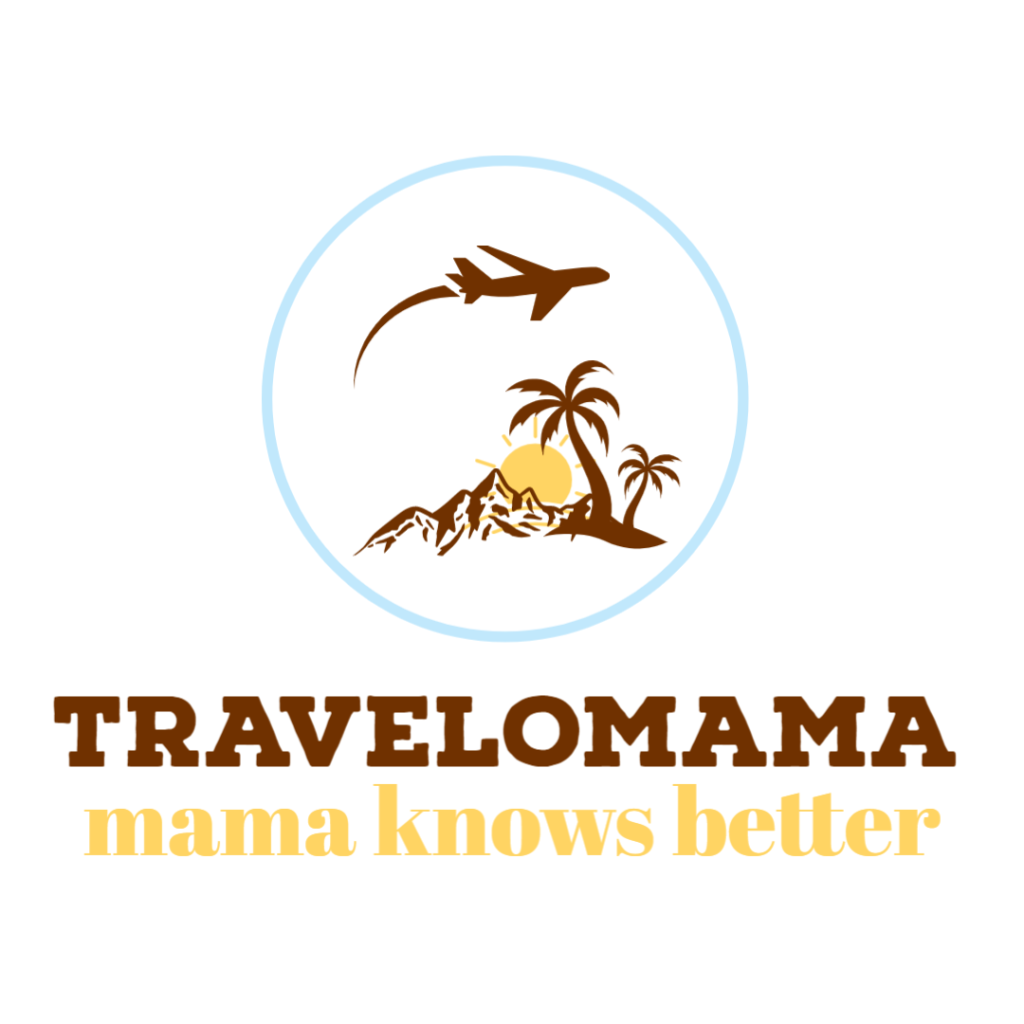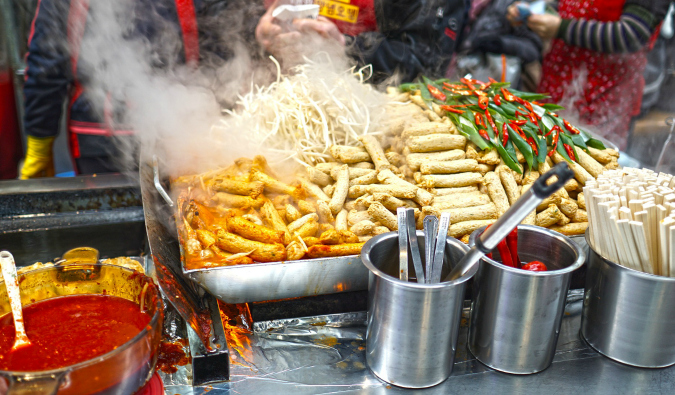 This is a guest post by Jodi Ettenberg, foodie extraordinaire and writer of The Food Traveler’s Handbook. She is one of my favorite travel bloggers, and it’s a honor to have her guest post here while I am in Africa!
This is a guest post by Jodi Ettenberg, foodie extraordinaire and writer of The Food Traveler’s Handbook. She is one of my favorite travel bloggers, and it’s a honor to have her guest post here while I am in Africa!
The beauty of traveling the world is that you can home in on the things you are most curious about or the themes that bring you joy. For many people, this means adventure or volunteering or climbing as many mountains as possible. For me, it means eating my way around the world and learning about food.
I never started out this way. I planned my travels to last one year, expecting to return to my lawyering job in New York in 2009. After saving up as much as I could, I started a site, Legal Nomads, to document whatever adventures came my way. I never thought that I would be still writing years later, and certainly did not expect to have written a book about food.
Somewhere between Mongolia and China, I figured out that what I ate would become more of a focus for my travels. Growing up, food was never a big part of my life, but as time went on and I began to travel, it was obvious that my destination choices and daily schedules were planned around my taste buds. Moreover, I wanted to travel so that I could learn about what people ate and why. It wasn’t just about the enjoyment of a meal or two but went much deeper. How was it that these tastes and traditions that fascinated me came together to form the historical backdrop for countries I was only beginning to explore? Food was a never-ending source of wonder (and delicious meals).
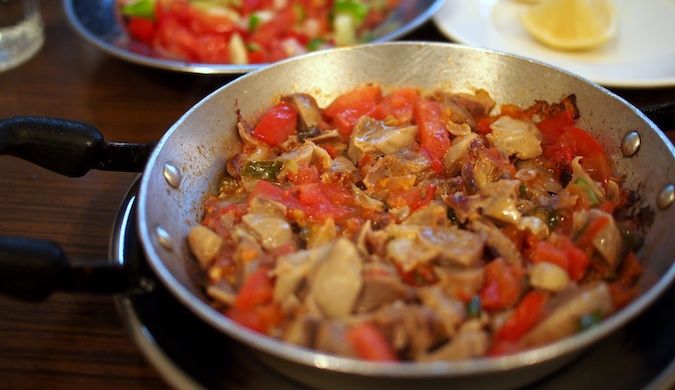
But for those who want to do what I do, there are some valid concerns. How do you eat safely, without getting sick? What do you need to pack before you go that helps you on your tasty travels? And what do you need to know to build out an itinerary based around food?
I just wrote a book, The Food Traveler’s Handbook, answering these questions and more, and Matt asked me to post my thoughts here about how I eat the world.
Here are my five tried-and-true tips and tricks for discovering the hidden secrets of food:
Start with the basics: the dishes themselves. One of my favorite places to start is Wikipedia, specifically its page on national dishes. Jumping from that landing page through to the ingredients named in it, or a historical footnote that fascinates you, means that you can take a journey though the anthropology of a country’s food before you even set off. For example, many travelers do not realize that ketchup’s origins lie thousands of miles away from America, in Fujian, China. By learning about that history before you set off to a trip to China, you are afforded a whole other lens through which you can view your adventures. A delicious lens at that!

You’ll appreciate food more if you also learn about the etiquette and social mores that accompany it. Part of the fun in learning about food is also trying to understand and/or mimic the cultural and food habits of the countries you visit. I’ve found asking locals about their traditions or their table habits is an excellent conversation starter. For example, in much of Asia, staking your chopsticks vertically in rice is frowned upon, because it is a Buddhist rite for the dead to burn incense in a bowl of rice at the altar. And asking about this topic at a dinner in Bangkok turned into a long discussion about the many other food quirks in our respective countries. Pre-trip, a good starting point for learning is Etiquette Scholar’s international dining etiquette section, divided into regions.
Two brief packing tips. Whether you travel with or without food, a good first aid and medical kit is important, as are my recommended packing essentials like a headlamp, doorstop, and safety whistle. For my first aid kit’s full contents, see my resources page. But what about packing for the food traveler? Specifics include the following:
- I never leave home without portable chopsticks, great where food is fresh but the street stall’s dishes may not be as clean as you’d like. An alternative is bringing baby wipes or Wet-Wipes with you to wipe down the utensils. That’s not to say I wander around disinfecting all of the cutlery, either! But for those street stalls with a fast turnover but less exciting washing methods, it’s always good to take that extra step.
- I also carry a Point-It Dictionary, easy to use when the language barrier gets in the way. You can point at the animal, condiment, or other item in the book and be guaranteed a minimum of communication. For those with iPhones, an alternative is ICOON, a picture dictionary.

Don’t ignore breakfast options. Be it nasi lemak in Indonesia or mohinga soups in Myanmar, breakfast is often an ideal time for you to explore your destination’s culinary offerings. Another option, particularly in Southeast Asia and South America, is to find the fresh food markets at dawn — they will almost always have food stalls attached, where shoppers stocking up on ingredients stop for a meal. Turnover is fast, the food is fresh, and it is almost always cheap.
What about food safety? Street stalls and markets are the best way to try food and not break the bank, but their safety is a concern for a lot of people. To be honest, I’ve been sicker from restaurants more often than from street stalls on my travels. The beauty of frequenting streetside restaurants is that they are open and accessible; you can see how the food is treated and cooked, and how clean the stall is — or isn’t.
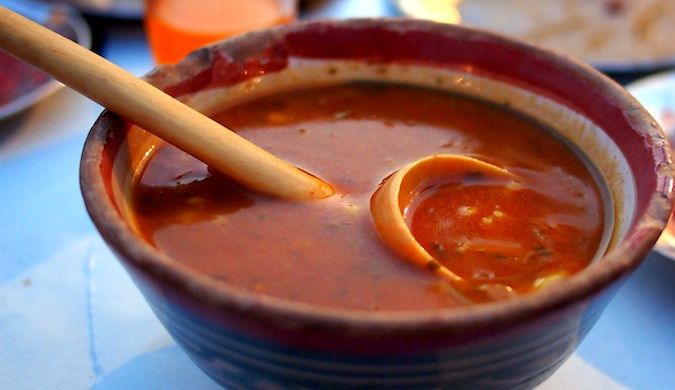
Other tips:
- I aim for stalls where the person cooking is not also handling the money, and if they are, then they are handling that money with gloves on, taking them off to cook the food.
- I also take a close look at how the town or country eats; if a big meal for locals is at lunchtime, that would be my choice for experimenting with new meats or exciting dishes, when the food is freshest.
- For those with food allergies or restrictions such as avoiding meat or dairy, Select Wisely has allergy and/or food cards that you can print out and take with you in the local language. Very helpful for a celiac like me who has to avoid gluten, wheat, barley, and rye!
These are but a few tips that can help guide you toward safe, delicious, and inexpensive eats on your travels. While food wasn’t a priority when I started traveling, I’ve found it an excellent addition to what was already a fulfilling experience. By focusing on food, I’ve added some fascinating stories, found great new friendships, and — of course — eaten some delicious meals. If you have any food questions, I’d be happy to answer them at or in the comments.
Bon appétit!
Jodi Ettenberg has been eating her way around the world since April 2008. She is the author of the recently published Food Traveler’s Handbook. She is also the founder of Legal Nomads, which chronicles worldwide travel and food adventures, and she is a contributing editor for Longreads. She gets the shakes when she goes too long without eating sticky rice.
How to Travel as a Vegetarian
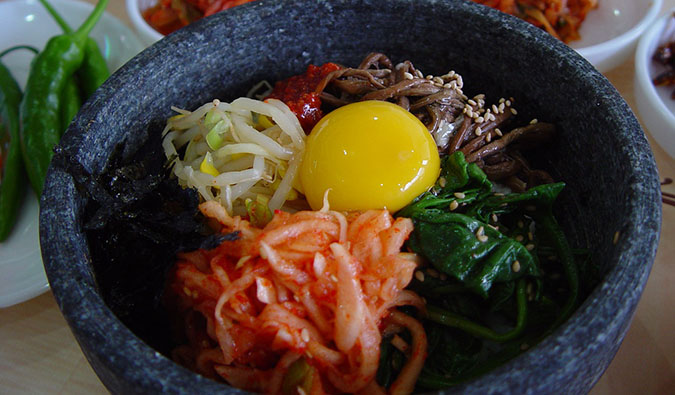 Traveling with dietary restrictions can be challenging, but it shouldn’t stop you from seeing the world — even on a backpacker’s budget. Blogger and food tour leader Akila McConnell has been a devoted vegetarian her entire life. In this guest post, Akila offers unconventional tips and practical advice for traveling the world as a vegetarian backpacker.
Traveling with dietary restrictions can be challenging, but it shouldn’t stop you from seeing the world — even on a backpacker’s budget. Blogger and food tour leader Akila McConnell has been a devoted vegetarian her entire life. In this guest post, Akila offers unconventional tips and practical advice for traveling the world as a vegetarian backpacker.
When we tell people that we’re traveling around the world, the first question I get is, “But, how do you eat?”
I was raised a vegetarian, stuck with my vegetarianism through college in the South (the land of vegetables boiled with ham hocks), and wasn’t going to change my eating habits because of our round-the-world trip. At the same time, eating is one of the main reasons we travel, so one year of boring salads and convenience store packaged foods wasn’t going to cut it. The good news is that after eight months on the road, I’m still a happy vegetarian backpacker because I follow these four rules:
1. Learn the local language.
Many languages have a word that means “vegetarian,” but I’ve often found that term is not used. For example, we’re currently in Japan, where “bejetarian” means “vegetarian,” but I’ve received many blank looks because Japanese people don’t use that word. On the other hand, if I ask for “yasai” dishes, they’ll offer me vegetable-based meals.
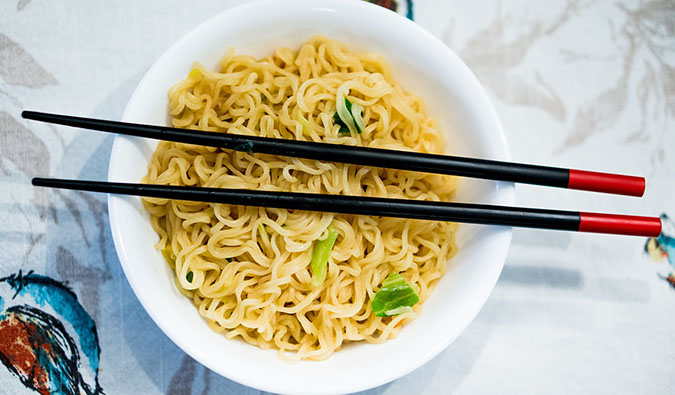
“Vegetarian” also means different things in different countries. In Thailand, the translation for vegetarian can also mean fish stock. If you say “jai ka,” the restaurant will offer you Buddhist vegetarian meals, which don’t include any meat products or onions or garlic.
To make sure your dietary concerns are understood, write down a few phrases before you go. “I cannot eat fish. I cannot eat meat.” Translate these into the local language so you can show them to the staff at the restaurant. That way you can communicate clearly and make sure everyone is on the same page. Conversely, if you’re traveling with a smartphone and access to data, you can download the local language and use the Google Translate app to communicate.
2. Do some research
HappyCow.net contains a listing of vegetarian restaurants across the world, and most guidebooks provide a “vegetarian listing.” I highly recommend finding locals who speak English to ask for recommendations. In Florence, our hotel owner recommended La Cipolla Rossa, a restaurant that specialized in creative Italian dishes. My husband ate a perfectly cooked steak while I was served a beautiful vegetarian entrée consisting of grilled vegetables and cheese.
For additional restaurant tips, use an app like Couchsurfing to talk with locals. You can filter local hosts by words like “vegetarian” or “vegan” so just do a local search and then message anyone who shares your diet. What are their favorite local restaurants? Are there any local hidden gems that might now be on Happy Cow? By reaching out to locals you’ll not only get great tips but you might be able to find someone to join you!
In addition to searching for specific restaurants, research local specialties. Nearly every country specializes in some vegetarian item, like tofu and tsukemono (pickled vegetables) in Japan, amarillos (fried plantains) in Puerto Rico, gazpacho in Spain, and bibimbap (a medley of rice, vegetables, and eggs) in Korea. At the same time, in certain countries, vegetarian specialties have “hidden” meat products; for example, most Thai and Cambodian recipes are made with fish sauce, so it’s important to specify no fish sauce when ordering those dishes.
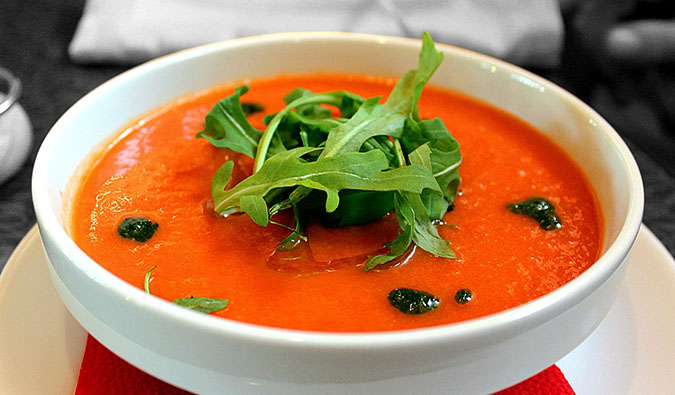
3. Be willing to move on
Unlike high-end restaurants that can afford English-speaking staff and an abundance of options, mom-and-pop restaurants frequented by backpackers may not have the ingredients available to cook vegetarian meals. If you talk to the wait staff and they can’t make anything, thank them for the trouble and move on to a different restaurant. Often you might end up eating a dish without meat but that has been cooked with an animal-based product simply due to miscommunication. This might not seem like a big deal for some, but not eating meat for some time will make it hard for your body to digest. Chances are you’ll end up sick (or with a stomach ache at the very least). Don’t risk your health, just politely say thanks and move on.
4. Carry backup supplies
On our last night camping in Australia, I was offered a baked potato and potato chips for dinner while the rest of the group ate grilled chicken and baked potatoes. I supplemented that inadequate carb-heavy meal with my backup stash of granola bars. We always carry one day’s worth of healthy snack items, which we restock in major cities.
Finding vegetarian products in big cities is usually fairly easy: granola bars, trail mix, nuts, and packets of dried fruit are available in supermarkets and convenience stores. In small towns where packaged produce may not be as readily available, we haunt the neighborhood markets for fresh fruits and vegetables. If you’re going somewhere that might not have the snacks you need or want, bring them with you before you leave home.
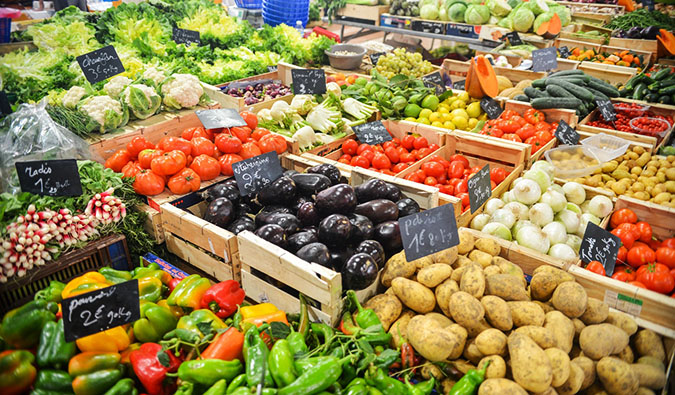
I admit that it’s a little more difficult to find options for me than for my omnivorous husband. Yet you can always find vegetarian food if you think creatively. In Italy, most first courses or primi piatti are vegetarian-based pasta dishes, so I often ordered two first courses rather than a first course and a main course. Though most Irish meals consist of some type of beef, soups and baked potatoes are served in nearly every pub. In Japan, a famously seafood-driven society, most Buddhist and Shinto temples offer a reasonably priced vegetarian meal for lunch. For the vegetarian traveler, eating on the road doesn’t have to be all salads, but it does take a bit more thought and work.
Akila’s mind (and waistline) expands as she travels and eats across the world. She is currently based in Atlanta and owns the food tour company, Atlanta Food Walks, a food tour that highlights Atlanta’s undiscovered neighborhoods, restaurants, and art It even contains recipes for healthy and easy-to-make dishes. When she isn’t busy leading tours, she’s writing and blogging about food.
- My 18 Current Favorite Restaurants in Europe
 As I buried my face into the piping hot crêpe, I couldn’t help but realize how much I eat when I visit Europe. After gorging on Nutella, cheese, sausage, beer, pasta, goulash, or whatever else is put in front of me as I traverse the continent every summer, my bikini body needs some work. Europe has just too many world-class places to eat, drink, and be merry!
As I buried my face into the piping hot crêpe, I couldn’t help but realize how much I eat when I visit Europe. After gorging on Nutella, cheese, sausage, beer, pasta, goulash, or whatever else is put in front of me as I traverse the continent every summer, my bikini body needs some work. Europe has just too many world-class places to eat, drink, and be merry!
But, as I took that second bite, I thought, “Screw it. Bring me a second crêpe. You only live once!”
And so I continue eating my way across the continent.
A few years ago, I listed my favorite restaurants in Europe, but since that time, I’ve eaten a lot of food at a lot of new restaurants. I’ve been to new cities, countries, and locales that deserve some culinary attention, so today, it’s time to share a second list of eateries in Europe that — while they may ruin your bikini body — will bring you a lifetime of bliss and memories:
Le Dit Vin (68 Rue Blanche, Paris)
I stumbled across this restaurant while looking for a place to eat near my Airbnb. I spied lots of wine bottles on the wall and someone eating cheese and thought “PERFECT!” It was an incredible find. The prices are reasonable (under 15 euros [$16 USD] for a meal), there is a large wine selection (it’s Paris, of course!), and the food is rich, savory, and delicious. The menu changes daily depending on what’s fresh, so all I can really recommend as a constant is the cheese plate.
Moeders (Rozengracht 251, Amsterdam)
Meaning “mothers” in Dutch, this restaurant is famous for serving traditional Dutch cuisine. It’s a small place (you’ll want to make reservations) filled with portraits of people’s mothers (feel free to add to their collection!) with outdoor seating in the summer. The best value is the Dutch sampler for two, where you can sample a heaping of traditional Dutch food, including lots of potatoes, cabbage, and meat. The fish of the day is always a winner, as is their carpaccio, spare ribs, and hotchpotch (a thick stew with vegetables and meat). A main will set you back 15-20 euros ($16-22 USD) but it’s worth the price!
U Medvídku (Na Perštýn 7, Prague)
This restaurant is one of the oldest in the city and somewhere I take my tour groups every year. Czech food is heavy on the meat and potatoes, and this spot is no exception. Here you can find a mouthwatering selection of home-brewed beer, heavy goulash, thick potato dumplings, duck, and perfectly cooked pork. Portions are huge (the pork knee is really for two). Prices are 120-200 CZK for a meal. (Another excellent place that serves traditional food is Kravin (Námstí Míru 109/18, Prague), which is a popular after work drinks destinations).
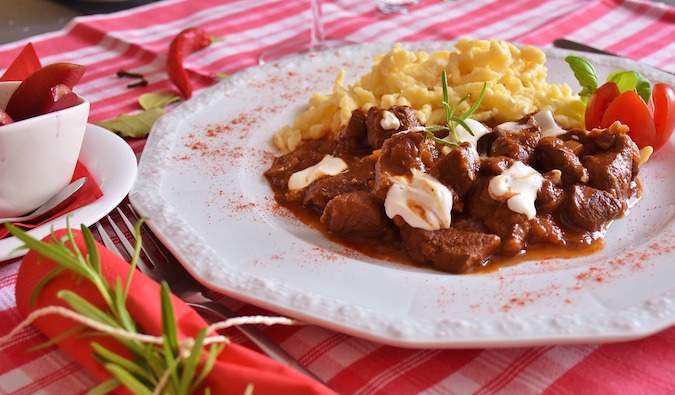
The Naschmarkt Vienna
Centrally located near the main ring road of Vienna, this outdoor market is lined with restaurants, cafés, and wine bars and is popular with locals and — thanks to lots of mentions in guides and blogs — tourists alike (yes, I’m doing my part!). You’ll be able to choose from a selection of kebab vendors, snack shops, and vegetarian restaurants. (You’ll also find food stalls selling vegetables and deli goods, but prices are higher than other markets in town so I wouldn’t recommend getting those things here.) On a warm day, I love coming here and eating outside and having a glass of wine.
Der Wiener Deewan (Liechtensteinstraße 10, Vienna)
This all-you-can-eat, pay-what-you-want Pakistani restaurant is popular with students (and cheapos like me; most people pay 5-10 euros for their meal). It’s also insanely tasty, serving up daal, naan, salads, chicken, chutney, and at least a few other dishes (usually around six total) each night. Because it is so cheap and tasty, it is always crowded, so if you’re a big group or going during peak eating hours, you’ll most likely need to wait for a seat. I visit every time I’m in Vienna.
Aneka Rasa (Warmoesstraat 25-29, Amsterdam)
There’s a lot of Indonesian food in Amsterdam, given their past colonization of the country. While there are many options in the city, I like this one the best because you get a lot of food for your money and it’s a great place for groups. You can order the sampler platter (about 10 dishes) for 20 euros ($21 USD) per person. You’ll leave full and with leftovers for later. I’m especially addicted to the rice cakes they bring out as an appetizer.
Leo Burdock (4 Crown Alley, Temple Bar, Dublin)
This well-established restaurant (over 100 years old!) serves fantastic fish and chips. It’s simple, easy, and delicious. Unlike a lot of other fish-and-chips shops, I didn’t find the food here too oily; it was perfectly fried and crisp. They don’t have an extensive menu, instead focusing on making a few dishes incredibly well. At 10 euros ($11 USD) for fish and chips, it’s a delicious place for an affordable and filling lunch. There are four Leo Burdock locations in and around Dublin.
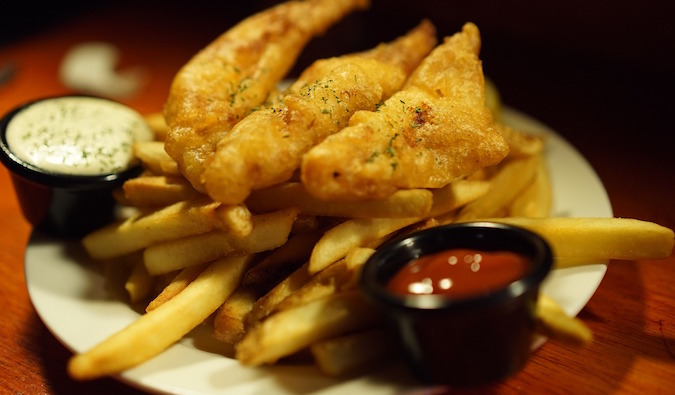
The Laundromat Café (Austurstræti 9, Reykjavík)
This cute café right on the main drag is famous and serves what I can only call American fare: burgers, pasta, sandwiches, and salads. While expensive (it’s Iceland, yo!), it’s also damn tasty. They offer excellent coffee and pastries, and you’ll find lots of people reading and writing in their comfy chairs and at tables.
Sægreifinn – The Sea Baron (Geirsgata 8, Reykjavík)
Turns out one of my readers in Iceland happens to be a government official, and when she took me here, I knew it had to be good. This tiny, hole-in-the-wall seafood place serves thick lobster soup with huge chunks of lobster and nice creamy broth. I’ve since heard it’s pretty famous, but when we went, there were no crowds and only Icelanders there. Regardless of who frequents it now, it’s delicious and shouldn’t be skipped.
Berlin’s Thai Market
I’ve been a Thai food snob ever since living in Thailand. Even the best places in the world make me go “meh,” but this weekend food market (though there are some weekday vendors) sees Thais setting up mini stalls and selling street stall–style food just like they do back home, unencumbered by German regulation. It’s the most authentic Thai food I’ve found outside Thailand (and it’s super cheap at only a few euros per dish). Here you can gorge on pork noodle soup, som tam, Thai ice tea, and real street-style pad gra pow! Heaven!

Vinograf Míšenská (Míšenská 8, Prague)
More of a wine bar (featuring hundreds of Czech vintners), they make the list because they do serve a yummy cheese and meat plate, too! The small, intimate setting with walls covered in wine bottles offers a quite respite from the noise of the streets.
Txalaka (Carrer Bonastruc de Porta, Girona, Spain)
Oddly located near a big car park and away from the town’s downtown, this restaurant serves buffet-style tapas: you just go and pick what you want. Most dishes are only a few euros and the selection is extraordinary — it’s pretty much every tapa you can imagine (I especially liked the shrimp). Grab some food, sit out side with your friends, drink a glass of wine, and eat at one of the best spots in the city.
Hermans (Katarina, Sofia Fjällgatan 23B, Stockholm)
This is an all-you-can-eat vegetarian buffet overlooking the harbor. Even though meat isn’t on the menu, the food is worth coming for. You have a wide selection of ever-changing options: healthy salads, home-cooked warm breads, hot dishes, a smorgasbord of fruits, and lots of desserts. Their 100 SEK ($11.50 USD) lunch buffet is extremely popular and fills up fast. Get there early. If you have a large group, you’ll need to make reservations. During the summer months, there’s outdoor seating.
La Crêperie des Arts (27 Rue Saint-André des Arts, Paris)
Located on the Left Bank near the Saint-Michel–Notre-Dame train station, this tiny to-go crêperie is the best one in all of Paris (in my opinion). The banana Nutella crêpe is my favorite. Cheap, savory, and with large portions — you can’t go wrong here.

Pancakes! (Berenstraat 38, Amsterdam)
This spot serves traditional Dutch pancakes: large thin, crêpelike pancakes with tons of tasty toppings (I’m a big fan of the strawberries and whipped cream!). It’s small, so try to avoid peak eating times as the wait can get quite long. Large portions make this place worth your time and money. Most pancakes are around 8 euros ($8.50 USD).
Café de Jaren (Nieuwe Doelenstraat 20-22, Amsterdam)
Serving typical café food (soups, salads, sandwiches), this place is located on the main Amstel canal, with an incredible view of the city. It has an awesome outdoor area, serves beer, and has Wi-Fi in case you want to work! I love coming here to sit, relax, and enjoy the view!
Jeanne A (42 Rue Jean-Pierre Timbaud, Paris)
This eat-in épicerie and wine shop offers country-style food (especially meats and cheeses) and is my favorite spot in Paris. The prix-fixe menu offers the best value at 30 euros ($32 USD) for dinner with an appetizer and main dish. Be sure to try their lamb and duck — they are famous for it!
Café Père & Fils (86 Rue Montmartre, Paris)
Located in the heart of Paris, this is a Parisian brasserie and coffee shop with outdoor seating for lunch and drinks. It gets busy on warm, sunny days when all the nearby office workers take over the patio for lunch. There are daily happy hours and brunch on Sunday.
I’m no food writer, so my descriptions may not conjure up images worth salivating over, but trust me when I say these places are worth a visit. When I travel, I eat at a lot of random, suggested, and guidebook-listed restaurants. Not every one is a winner and, even if it’s good, it may not knock my socks off. These, though, knock both my socks off, put them back on, and knock them off again.
